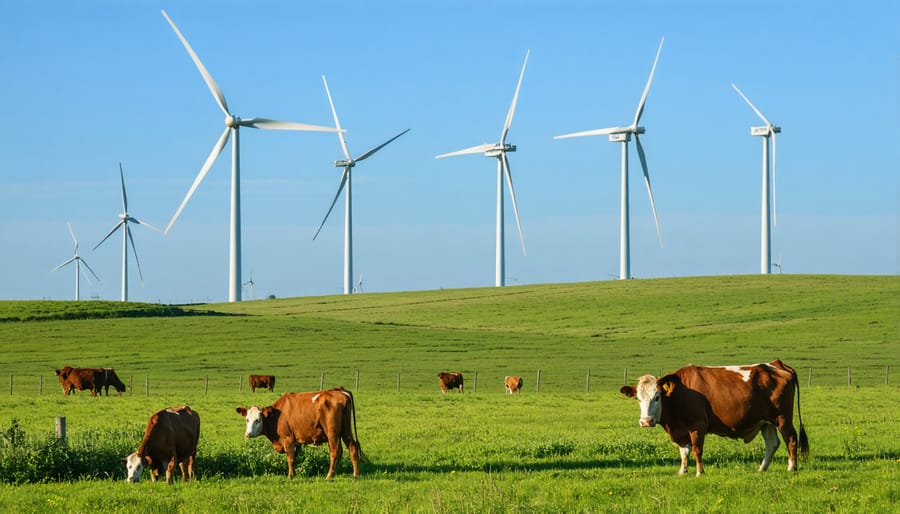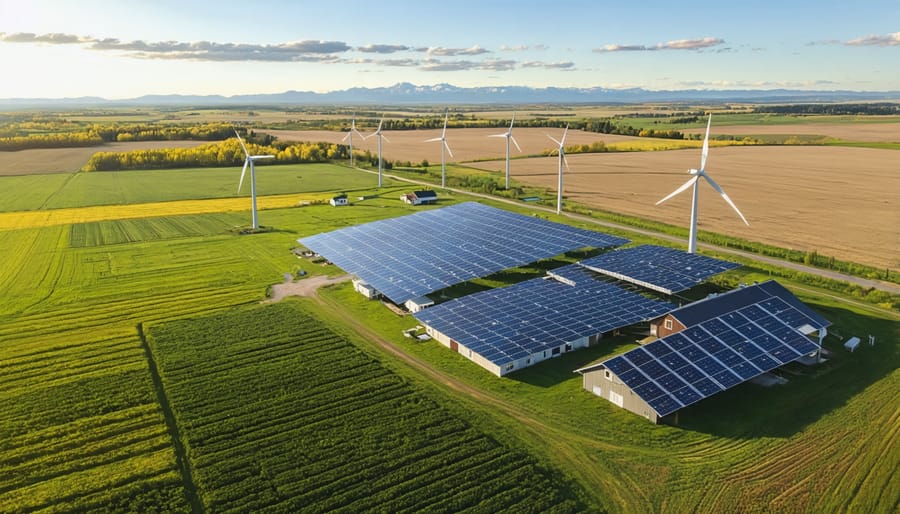Harness the power of green energy to revolutionize your agricultural operations. From solar panels that slash electricity costs to anaerobic digesters that transform waste into fuel, cutting-edge technologies are making sustainable farming more accessible and profitable than ever before. Forward-thinking Alberta producers are already reaping the rewards, with early adopters reporting energy savings of up to 70% and new revenue streams from carbon credits and clean power sales. As government incentives and financing options multiply, there’s never been a better time to embrace the green energy transition and position your farm for long-term success in a low-carbon future.
Solar-Powered Irrigation Systems

How Solar Irrigation Works
Solar irrigation systems harness the power of the sun to pump water for agricultural purposes. The main components include solar panels, a pump, and a water storage tank. Solar panels convert sunlight into electricity, which powers the pump to draw water from a well, pond, or river. The water is then stored in a tank for later use or directly fed into irrigation lines. Proper sizing of the solar array and pump is crucial for optimal performance. Factors such as water source depth, required flow rate, and irrigation area are considered when designing a system. Solar irrigation offers numerous benefits, including reduced energy costs, increased water access in remote areas, and lower carbon emissions compared to fossil fuel-powered pumps. Additionally, the integration of solar panels with crops, known as agrivoltaics, can provide shade and improve water efficiency. With advancements in technology and declining costs, solar irrigation is becoming an increasingly attractive option for Canadian farmers looking to adopt sustainable practices and reduce their environmental impact.
Financing and Incentives
The Government of Canada and the Province of Alberta offer various financing options and incentives to support farmers in adopting green energy technologies. The Canadian Agricultural Partnership (CAP) provides cost-shared funding for projects that improve environmental sustainability, including solar panels, wind turbines, and anaerobic digesters. Farmers can access up to $50,000 per project through the CAP’s Environmental Sustainability and Climate Change program.
The Alberta Growing Forward 3 program also offers grants for energy-efficient upgrades and renewable energy installations on farms. Eligible projects can receive up to 50% of costs, with a maximum of $100,000 per applicant. Additionally, the federal government’s Clean Energy and Sustainability Fund and the Agricultural Clean Energy Program provide financial support for clean technology adoption in agriculture.
Tax incentives are another way to offset the costs of green energy investments. The Canadian Renewable Conservation Expenses (CRCE) allows farmers to deduct expenses related to renewable energy projects from their taxable income. The Capital Cost Allowance (CCA) also provides accelerated depreciation rates for clean energy equipment, reducing the tax burden for farmers who invest in these technologies.
Lastly, many local utility companies and cooperatives offer net metering programs, allowing farmers to sell excess electricity generated from solar or wind back to the grid, providing an additional revenue stream. By leveraging these financing options and incentives, Alberta farmers can make green energy projects more affordable and reap the long-term benefits of reduced energy costs and enhanced sustainability.

Wind Energy for Farm Operations
Small-Scale vs. Large-Scale Wind
When considering wind energy for your farm, the scale of the system is a crucial factor. Small-scale wind turbines, typically producing less than 100 kW, are suitable for farms with lower energy needs or limited space. These systems are less expensive to install and maintain, making them an accessible option for smaller operations. However, their energy output may not be sufficient for larger farms or those with energy-intensive practices.
On the other hand, large-scale wind turbines, generating over 100 kW, are ideal for farms with higher energy demands or ample land available. These systems can significantly reduce or even eliminate reliance on grid electricity, leading to substantial cost savings over time. Large-scale wind energy can also provide a source of additional income through net metering or power purchase agreements. However, the initial investment and maintenance costs are higher compared to small-scale systems.
Ultimately, the choice between small-scale and large-scale wind energy depends on your farm’s specific energy requirements, available land, and financial resources. Conducting a thorough assessment of your farm’s energy needs and consulting with a wind energy specialist can help you determine the most suitable system size for your operation, ensuring you harness the power of the wind effectively and sustainably.
Siting and Permitting
When siting wind turbines on your farm, consider factors such as wind speed, topography, proximity to buildings and roads, and potential impacts on crops and livestock. Consult with experts to determine the optimal placement for efficiency and minimal disruption. In Alberta, wind energy projects may require permits from the Alberta Utilities Commission (AUC) and adherence to regulations like setback distances and noise limits. Work with your local municipality and the AUC to navigate the permitting process and ensure compliance with all applicable laws and regulations. Proper siting and permitting not only ensure the success of your wind energy project but also demonstrate respect for your community and the environment.
Anaerobic Digesters
Is a Digester Right for Your Farm?
Determining if an anaerobic digester is right for your farm depends on several factors. Typically, digesters are most viable for farms with at least 150 cows or 2,000 hogs, as they require a consistent supply of manure. The upfront costs can be substantial, ranging from $500,000 to $5 million depending on the size and type of system. However, digesters can generate significant long-term savings through reduced energy costs and potential revenue from selling excess electricity. Grants and financing options are available to help offset initial expenses. It’s important to carefully assess your farm’s waste volume, energy needs, and financial resources before investing in a digester. Consulting with experienced professionals and exploring case studies of similar farms can help determine if this technology aligns with your goals for sustainable and profitable agriculture.

Selling Power and Carbon Offsets
Connecting to the grid allows farmers to sell excess green energy back to utility companies, providing an additional revenue stream. Power purchase agreements (PPAs) enable long-term contracts with fixed rates, offering financial stability. Farmers can also explore carbon credit markets, where they earn credits for reducing greenhouse gas emissions through sustainable practices like no-till farming or planting cover crops. These credits can be sold to companies looking to offset their carbon footprint. In Alberta, the Carbon Competitiveness Incentive Regulation (CCIR) and the offset market provide opportunities for farmers to participate. By leveraging these options, agricultural producers can not only reduce their environmental impact but also diversify their income sources and support the growth of green energy in the province.
Geothermal Heating and Cooling
Geothermal System Types
There are three main types of geothermal systems used in agriculture: loop fields, heat pumps, and direct use. Loop fields involve underground pipes that circulate a fluid to exchange heat with the ground. This stable temperature can be used for greenhouse heating or cooling. Heat pumps, on the other hand, use the ground’s thermal energy to efficiently heat and cool buildings like barns or farmhouses. Lastly, direct use systems tap into naturally heated water reservoirs to provide heat for applications such as soil warming, greenhouse temperature control, or even food processing. While installation costs can be higher than traditional systems, geothermal offers reliable, renewable energy with low operating expenses. For Alberta farmers looking to reduce their carbon footprint and stabilize long-term energy costs, geothermal is an option worth exploring.
Alberta Geothermal Potential
Alberta possesses significant geothermal potential, particularly in regions along the Rocky Mountain foothills and the Northern Alberta basin. These areas are characterized by high heat flow and thermal gradients, making them promising for geothermal energy development. The Western Canada Sedimentary Basin, which underlies much of Alberta, contains deep aquifers with temperatures suitable for geothermal power generation and direct heating applications. Regions such as Hinton, Edson, and Grande Prairie have been identified as hotspots for geothermal exploration. Geothermal energy can be harnessed to heat greenhouses, provide space heating for farm buildings, and even power irrigation systems, reducing reliance on fossil fuels. Proper water infiltration management is crucial to maintain the sustainability of geothermal systems in agricultural settings.
Energy Efficiency Measures
Improving energy efficiency is a cost-effective way for Alberta farmers to reduce their environmental impact and save money. Simple measures like upgrading to LED lighting in barns and greenhouses can significantly cut electricity use. Proper insulation of buildings, using energy-efficient ventilation systems, and maintaining equipment can also make a big difference.
Precision agriculture techniques, which use technology to optimize inputs like fertilizer and water, are another smart efficiency strategy. For example, variable rate application allows you to apply just the right amount of nutrients based on soil conditions, reducing waste and costs. GPS guidance systems minimize overlaps in tilling, planting, and spraying, saving fuel and time.
Regularly monitoring energy use with smart meters can help identify areas for improvement. Small changes add up – installing timers and thermostats, using natural ventilation when possible, and choosing energy-efficient appliances all contribute. Farms can also save by upgrading to high-efficiency irrigation pumps and switching to electric or solar-powered farm equipment.
By combining these efficiency measures with renewable energy systems, Alberta farmers can take major strides towards net-zero operations. Government programs like the Energy Efficiency Alberta initiative and Canadian Agricultural Partnership offer valuable support. With some upfront investment and a commitment to continuous improvement, boosting efficiency pays off for both the planet and the bottom line.
Conclusion
In conclusion, green energy technologies such as solar, wind, anaerobic digesters, geothermal systems, and energy efficiency measures offer Alberta farmers a range of options to enhance sustainability and reduce their environmental impact. By embracing these solutions, agricultural operations can not only contribute to a greener future but also benefit from long-term cost savings and increased resilience. The transition to sustainable farming practices is crucial for the health of our planet and the viability of the agricultural sector. Alberta farmers are encouraged to explore the various green energy alternatives, seek guidance from local experts, and take advantage of available financing options to implement these climate solutions. By working together and sharing knowledge, the Alberta agricultural community can lead the way in building a more sustainable and prosperous future for generations to come.











